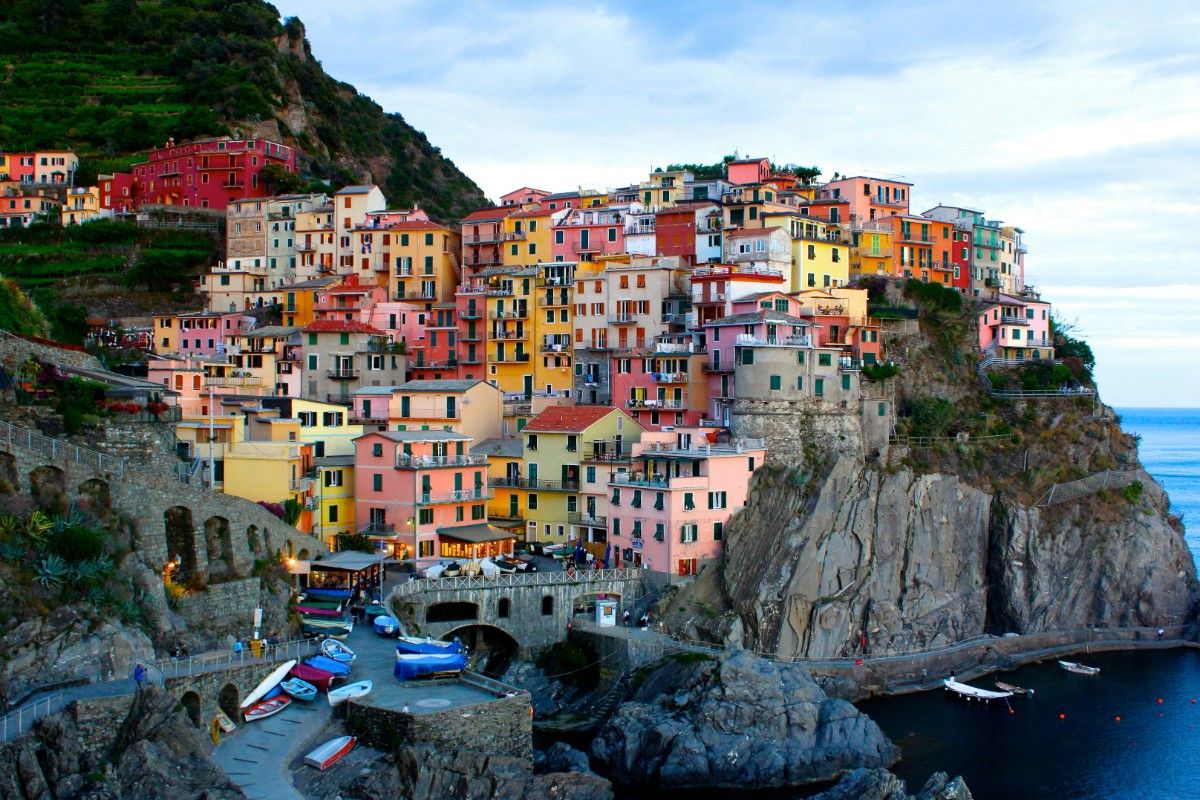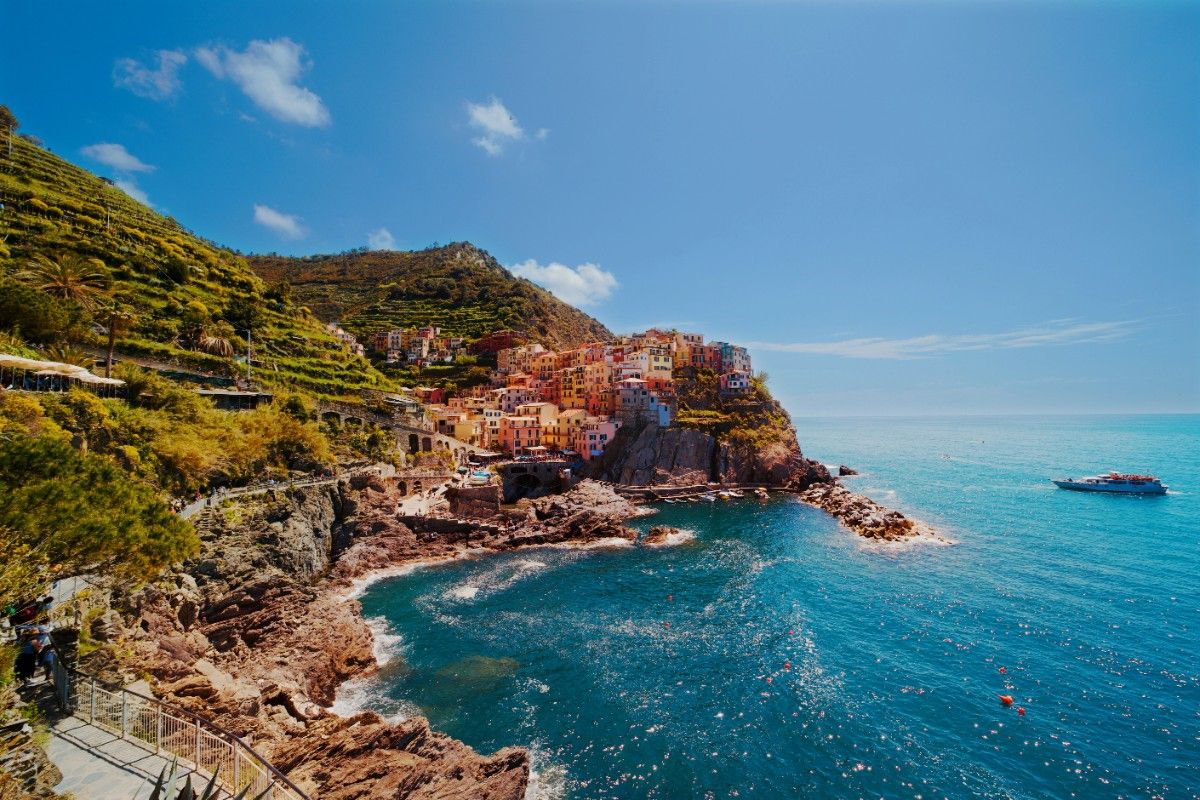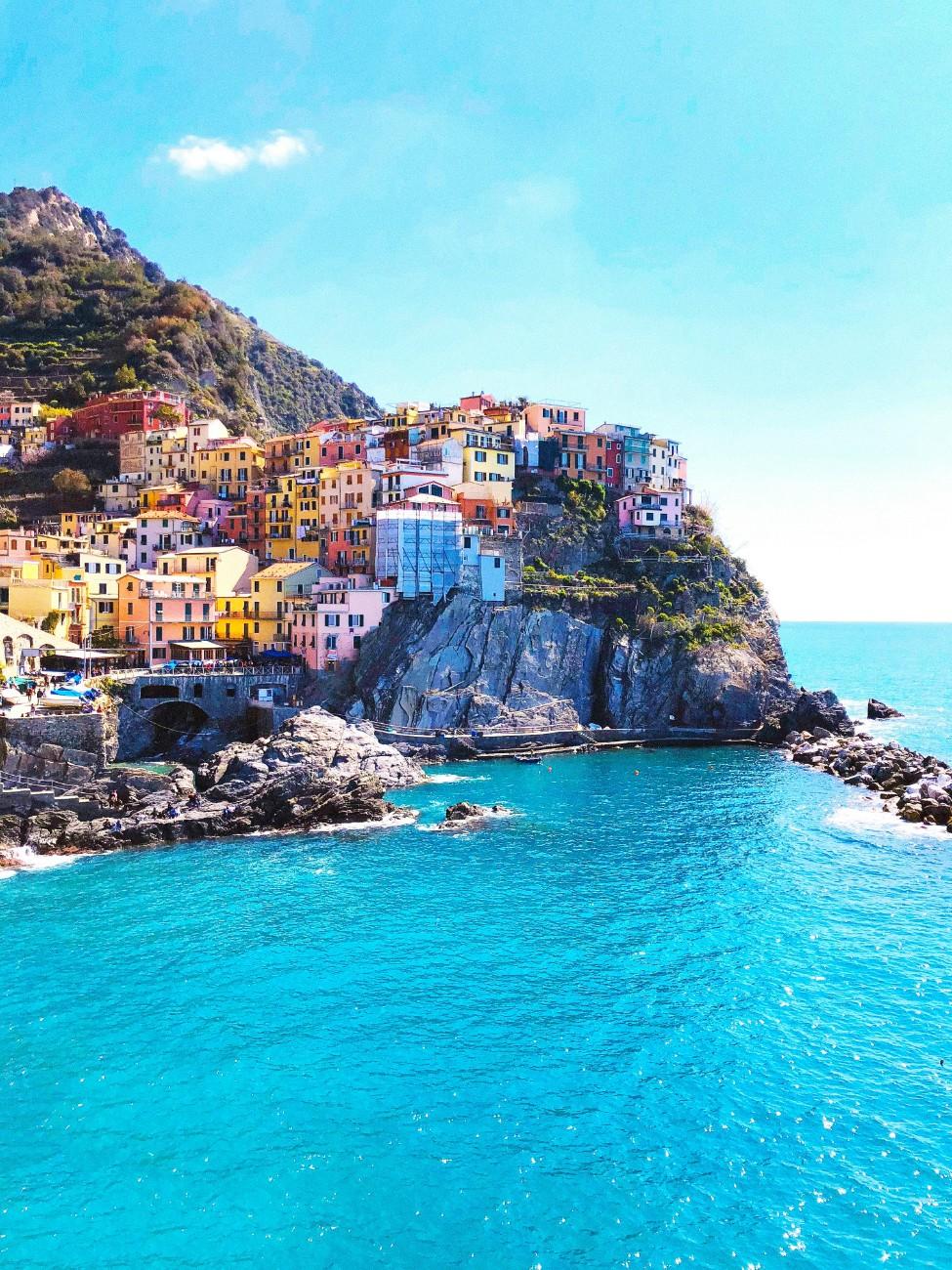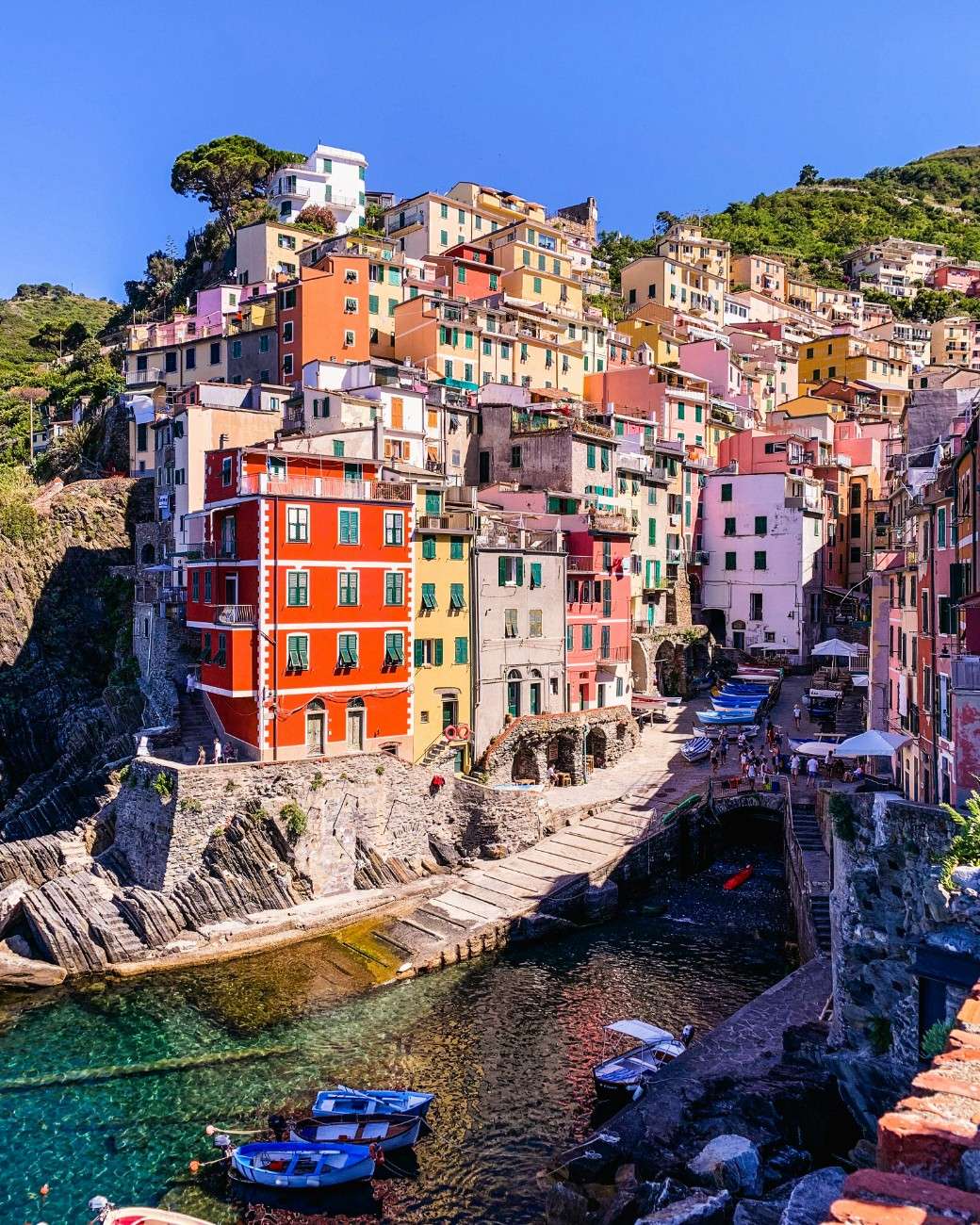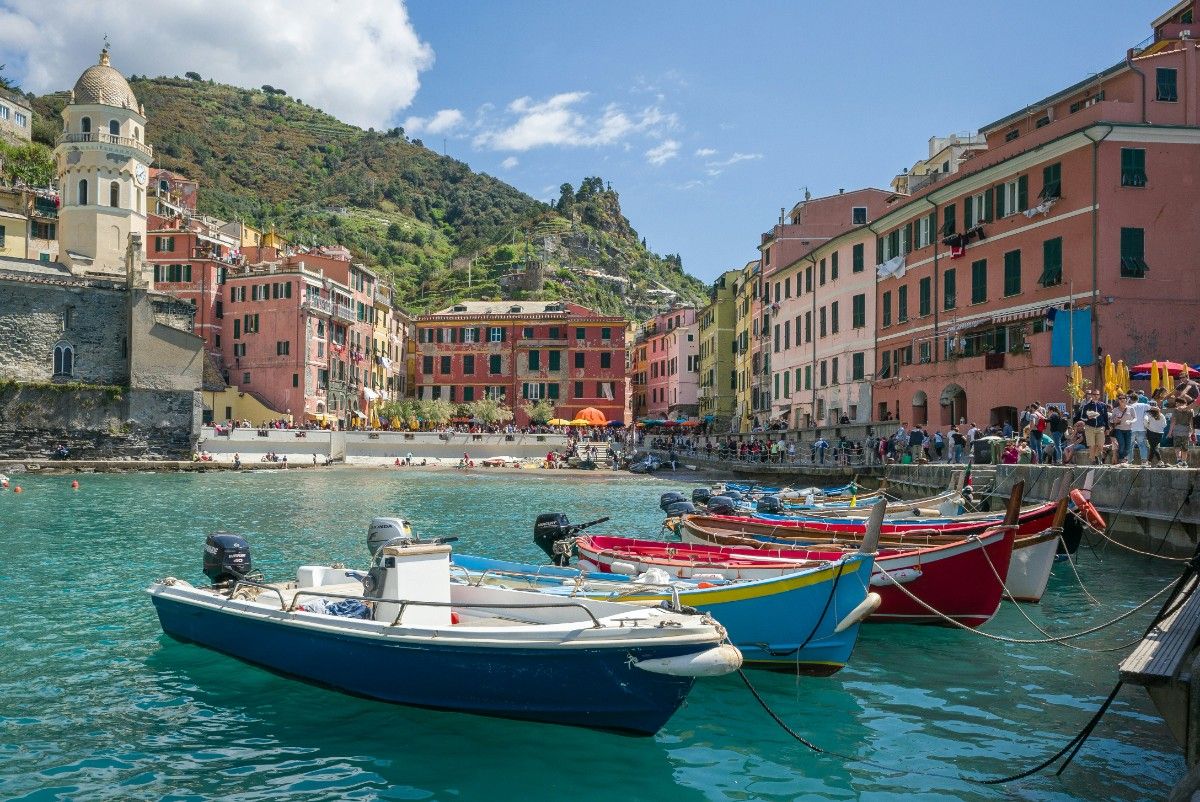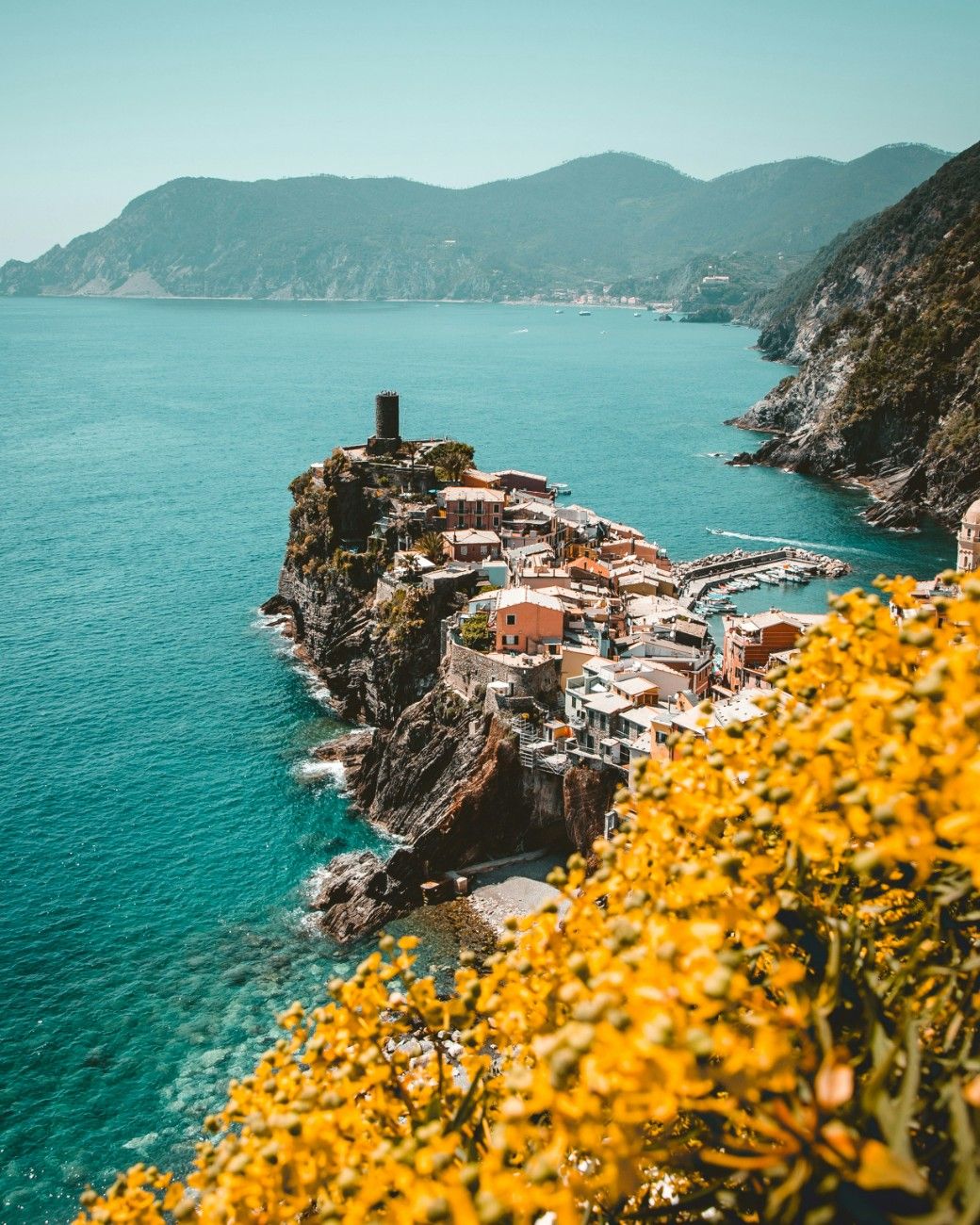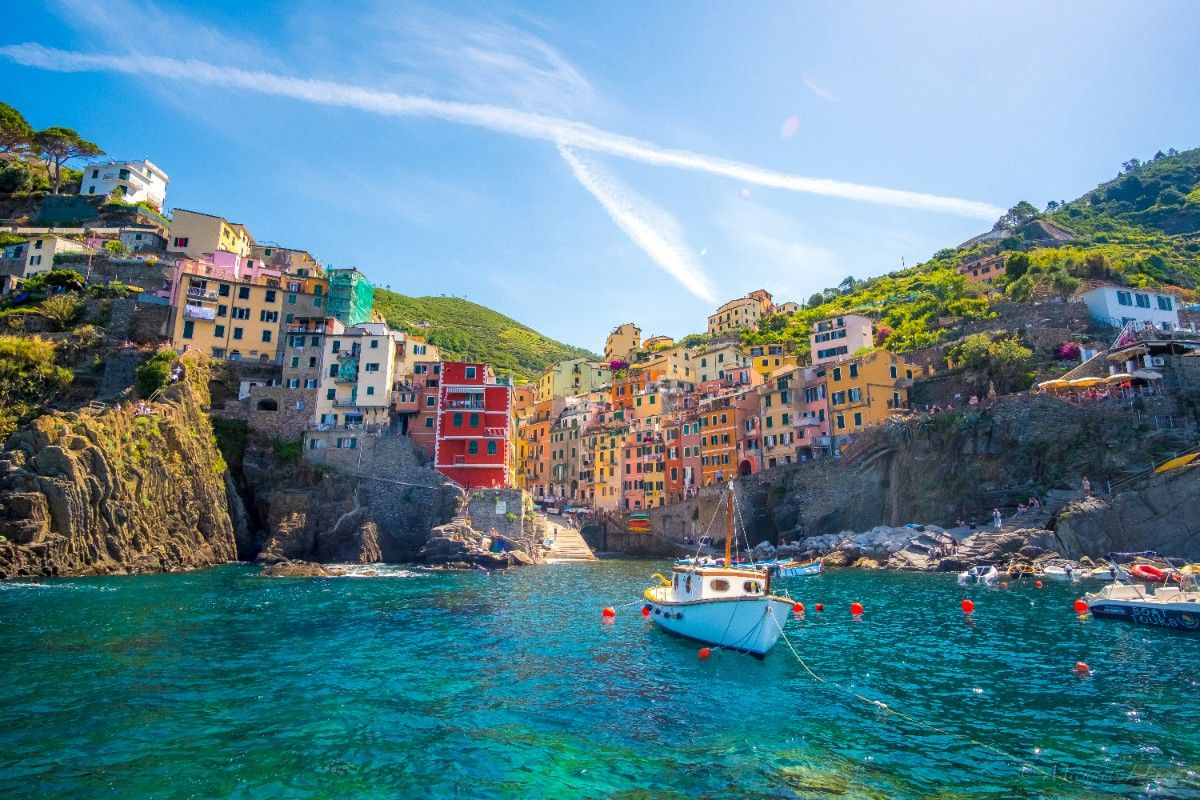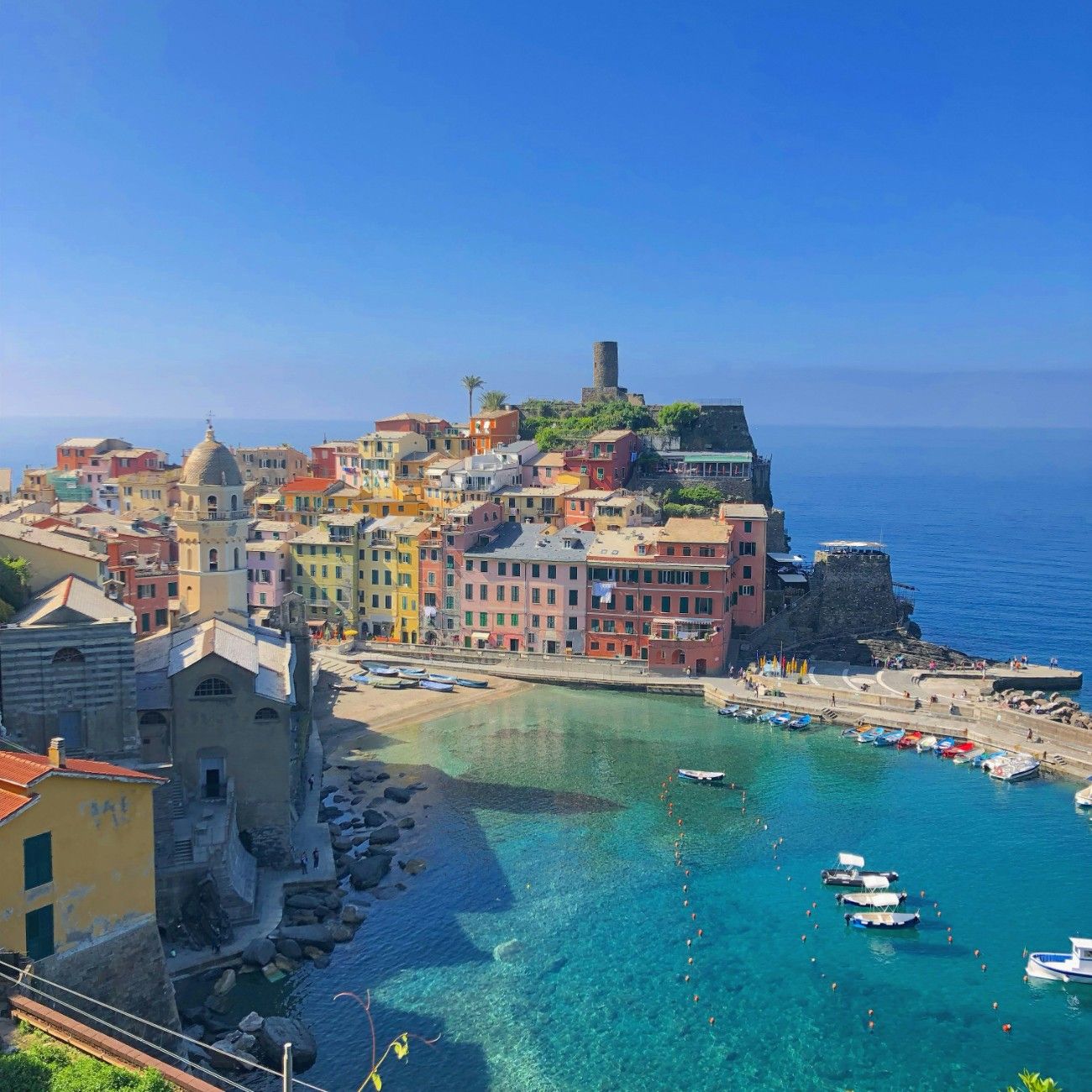Hiking the Cinque Terre
Introduction to Cinque Terre, Italy
The Enchanting Allure of Cinque Terre
Nestled along the rugged Ligurian coast of Italy lies a string of five picturesque villages known as Cinque Terre. This UNESCO World Heritage site, whose name translates to "Five Lands," has captivated the hearts of travellers from around the world with its breathtaking beauty, vibrant culture, and timeless charm. Cinque Terre, Italy, is a treasure trove of colourful houses clinging to steep cliffs, winding cobblestone streets, and bustling fishing harbours that paint a picture of a bygone era.
The five villages that make up Cinque Terre – Monterosso al Mare, Vernazza, Corniglia, Manarola, and Riomaggiore – are connected by a network of hiking trails that offer visitors a chance to immerse themselves in the stunning coastal landscape. These trails, including the famous Sentiero Azzurro or Blue Trail, wind through terraced vineyards, lemon groves, and olive gardens, providing hikers with unparalleled views of the shimmering Mediterranean Sea.
Beyond its natural beauty, Cinque Terre is also renowned for its rich history and cultural heritage. The villages have been inhabited since the 11th century, and the centuries-old traditions of fishing, winemaking, and agriculture are still an integral part of daily life. Visitors can explore ancient churches, medieval fortresses, and charming piazzas that serve as gathering places for locals and travellers alike.
A Journey Through the Five Lands
To truly appreciate the magic of Cinque Terre, Italy, one must explore each of the five villages that make up this enchanting destination. A Cinque Terre map reveals the unique layout of the region, with the villages spread out along the coast and connected by a network of trails and trains.
Monterosso al Mare, the largest of the five villages, is known for its long sandy beach, lush vegetation, and impressive 16th-century Capuchin monastery. Vernazza, often considered the most picturesque of the Cinque Terre towns, boasts a natural harbour, castle ruins, and a charming piazza dominated by the Church of Santa Margherita d'Antiochia.
Corniglia, perched high on a cliff, offers visitors a more tranquil experience, with its narrow streets, terraced vineyards, and panoramic views of the sea. Manarola, with its vibrant fishing harbour and popular swimming hole, is a favourite among photographers and artists. Finally, Riomaggiore, the southernmost village, is known for its steep streets, ancient castle, and the famous Via dell'Amore, a romantic walkway that connects the town to Manarola.
Discovering the Treasures of Cinque Terre
While the villages themselves are the main draw of Cinque Terre, there are countless other treasures waiting to be discovered in this enchanting region. The Cinque Terre National Park, established in 1999, protects the unique ecosystem and cultural heritage of the area, including the centuries-old terraced hillsides and the diverse flora and fauna that call the park home.
Food and wine lovers will delight in the culinary offerings of Cinque Terre, which showcase the best of Ligurian cuisine. From fresh seafood and homemade pesto to locally produced wines like the famous Sciacchetrà dessert wine, there are endless opportunities to indulge in the flavours of the region.
As you plan your visit to Cinque Terre, Italy, be sure to consult a Cinque Terre map to familiarise yourself with the layout of the villages and the hiking trails that connect them. Consider the weather in Cinque Terre when choosing the best time to visit, as the region experiences distinct seasons that offer different hiking conditions and experiences.
Whether you are seeking adventure, relaxation, or cultural immersion, Cinque Terre promises an unforgettable journey through one of Italy's most enchanting destinations. So pack your bags, lace up your hiking boots, and get ready to discover the magic of the Five Lands.
The Towns of Cinque Terre
Monterosso al Mare: The Largest of the Five Lands
Monterosso al Mare, the northernmost village of Cinque Terre, is the largest and most resort-like of the five towns. Split into two distinct sections – the old town and the new town – Monterosso offers visitors a wide range of experiences and amenities.
The old town, known as the Centro Storico, is characterised by its narrow, winding streets, colourful houses, and historic churches. The Church of San Giovanni Battista, a stunning example of Ligurian Gothic architecture, dominates the main square and is a must-see for any visitor. The old town is also home to the 16th-century Capuchin Monastery, which offers breathtaking views of the sea and the surrounding hillsides.
The new town, or Fegina, is where you'll find Monterosso's famous sandy beach, the only extensive beach in Cinque Terre. Lined with colourful umbrellas and beachside cafes, the beach is a popular spot for swimming, sunbathing, and people-watching. Visitors can also enjoy a variety of water sports, such as kayaking and paddleboarding, or take a boat tour to explore the coastline from a different perspective.
Monterosso is also known for its lush vegetation, including fragrant lemon groves and terraced vineyards that produce the region's famous white wines. The town's culinary scene is equally impressive, with numerous restaurants and cafes serving up fresh seafood, homemade pasta, and other local specialties.
Vernazza: The Jewel of Cinque Terre
Often regarded as the most picturesque of the Cinque Terre towns, Vernazza is a breathtaking sight to behold. The village is characterised by its natural harbour, colourful houses that seem to tumble down the hillside, and the iconic Doria Castle that watches over the town from its perch on the cliffs.
At the heart of Vernazza lies the Piazza Marconi, a lively square that serves as the social hub of the village. Surrounded by cafes, gelaterias, and souvenir shops, the piazza is the perfect spot to relax and soak up the local atmosphere. From here, visitors can wander the narrow, cobblestone streets that wind their way through the village, discovering hidden corners and stunning sea views at every turn.
One of the most iconic landmarks in Vernazza is the Church of Santa Margherita d'Antiochia, a beautiful Ligurian Gothic church that dates back to the 14th century. The church's octagonal bell tower and intricate rose window are particularly noteworthy, as is the stunning view of the harbour from its steps.
Vernazza is also a popular starting point for hiking the Cinque Terre trails, with the famous Sentiero Azzurro (Blue Trail) connecting the village to Monterosso to the north and Corniglia to the south. The trail offers hikers a chance to experience the breathtaking beauty of the coastline, with terraced vineyards, olive groves, and stunning sea views at every turn.
Corniglia: The Quiet Charm of Cinque Terre
Perched high on a cliff overlooking the sea, Corniglia is the smallest and most remote of the Cinque Terre villages. Unlike the other towns, Corniglia does not have direct access to the sea, but what it lacks in beaches, it more than makes up for in charm and tranquillity.
To reach Corniglia, visitors must climb the 382 steps of the Lardarina, a steep brick staircase that leads from the train station to the village centre. The climb is well worth the effort, as Corniglia's quiet streets, stunning views, and laid-back atmosphere make it a true hidden gem of the Cinque Terre.
At the heart of the village lies the Largo Taragio, a small square that serves as the main gathering place for locals and visitors alike. Surrounded by cafes, restaurants, and shops selling local products like honey, wine, and olive oil, the square is the perfect spot to relax and immerse yourself in the local culture.
One of the most striking features of Corniglia is its terraced vineyards, which cling to the steep hillsides surrounding the village. These vineyards produce some of the region's most famous wines, including the Vernaccia di Corniglia, a crisp white wine that pairs perfectly with the local seafood.
Corniglia is also home to several historic churches, including the Church of San Pietro, a beautiful Baroque church that dates back to the 14th century, and the Oratory of Santa Caterina, a small chapel with stunning frescoes and a panoramic terrace overlooking the sea.
Manarola: The Picture-Perfect Fishing Village
Manarola, the second-smallest of the Cinque Terre villages, is a picture-perfect fishing village that has captured the hearts of artists and photographers from around the world. The village is characterised by its vibrant pastel-coloured houses, winding streets, and stunning views of the sea.
At the heart of Manarola lies the Piazza Capellini, a small square that serves as the main gathering place for locals and visitors alike. Surrounded by cafes, restaurants, and shops selling local products like wine, olive oil, and handicrafts, the square is the perfect spot to relax and soak up the local atmosphere.
One of the most iconic landmarks in Manarola is the Church of San Lorenzo, a beautiful Gothic church that dates back to the 14th century. The church's facade is adorned with a stunning rose window and intricate carvings, while the interior features a magnificent wooden ceiling and a series of frescoes depicting scenes from the life of San Lorenzo.
Manarola is also famous for its wine production, particularly the Sciacchetrà, a sweet dessert wine made from dried grapes. Visitors can explore the village's terraced vineyards and learn about the traditional winemaking techniques that have been passed down through generations.
One of the most popular attractions in Manarola is the Via dell'Amore, a scenic walkway that connects the village to Riomaggiore, the southernmost of the Cinque Terre towns. The walkway, which is carved into the cliffs overlooking the sea, offers breathtaking views of the coastline and is a popular spot for romantic strolls and wedding photo shoots.
Riomaggiore: The Gateway to Cinque Terre
Riomaggiore, the southernmost village of Cinque Terre, is often referred to as the gateway to the Five Lands. The village is characterised by its steep streets, colourful houses, and stunning views of the sea.
At the heart of Riomaggiore lies the Via Colombo, the village's main street, which is lined with cafes, restaurants, and shops selling local products like wine, olive oil, and handicrafts. The street leads down to the picturesque harbour, where visitors can admire the colourful fishing boats bobbing in the water and watch the locals go about their daily lives.
One of the most iconic landmarks in Riomaggiore is the Church of San Giovanni Battista, a beautiful Gothic church that dates back to the 14th century. The church's facade is adorned with a stunning rose window and intricate carvings, while the interior features a magnificent wooden ceiling and a series of frescoes depicting scenes from the life of San Giovanni Battista.
Riomaggiore is also home to the Castello di Riomaggiore, a medieval castle that offers stunning views of the village and the sea. The castle, which was built in the 13th century to defend the village from pirate attacks, now serves as a museum and cultural centre.
One of the most popular attractions in Riomaggiore is the Via dell'Amore, a scenic walkway that connects the village to Manarola. The walkway, which is carved into the cliffs overlooking the sea, offers breathtaking views of the coastline and is a popular spot for romantic strolls and photo opportunities.
Riomaggiore is also a great starting point for exploring the other villages of Cinque Terre, with regular train and boat services connecting the village to Manarola, Corniglia, Vernazza, and Monterosso al Mare. Whether you choose to hike the scenic trails that connect the villages or simply soak up the local culture and cuisine, Riomaggiore is the perfect gateway to the magic of the Cinque Terre.
Hiking Trails in Cinque Terre
The Sentiero Azzurro: The Blue Trail
The Cinque Terre is a hiker's paradise, offering a network of trails that wind through the stunning coastal landscape and connect the five picturesque villages. The most famous of these trails is the Sentiero Azzurro, or the Blue Trail, which stretches for 12 kilometres along the coastline and offers breathtaking views of the sea and the colourful villages perched on the cliffs.
The Blue Trail is divided into four sections, each with its own unique character and level of difficulty. The first section, which connects Monterosso al Mare to Vernazza, is a relatively easy hike that takes around 2 hours to complete. The trail winds through terraced vineyards and olive groves, offering stunning views of the sea and the villages below.
The second section of the Blue Trail, which connects Vernazza to Corniglia, is a bit more challenging, with some steep ascents and descents. The trail takes around 1.5 hours to complete and offers breathtaking views of the coastline and the surrounding hillsides.
The third section of the trail, which connects Corniglia to Manarola, is currently closed due to landslides and safety concerns. However, hikers can still enjoy the stunning views of the sea and the villages by taking the train or a boat between the two towns.
The final section of the Blue Trail, which connects Manarola to Riomaggiore, is a short and easy hike that takes around 20 minutes to complete. This section of the trail is known as the Via dell'Amore, or the Way of Love, and is a popular spot for romantic strolls and photo opportunities.
The Sentiero Rosso: The High Trail
For hikers looking for a more challenging adventure, the Cinque Terre also offers the Sentiero Rosso, or the High Trail. This trail runs along the ridge above the five villages and offers stunning panoramic views of the coastline and the surrounding landscape.
The High Trail is a more strenuous hike than the Blue Trail, with some steep ascents and descents and a total distance of around 38 kilometres. The trail is divided into several sections, each with its own unique character and level of difficulty.
One of the most popular sections of the High Trail is the stretch between Portovenere and Telegrafo, which offers stunning views of the Gulf of La Spezia and the surrounding hillsides. This section of the trail takes around 5 hours to complete and is considered one of the most challenging parts of the High Trail.
Another popular section of the High Trail is the stretch between Telegrafo and Riomaggiore, which offers breathtaking views of the Cinque Terre villages and the sea. This section of the trail takes around 3 hours to complete and is considered a moderate hike.
Other Hiking Trails in Cinque Terre
In addition to the Blue Trail and the High Trail, the Cinque Terre offers a variety of other hiking trails that offer unique experiences and stunning views of the coastline and the surrounding landscape.
One of these trails is the Sentiero SVA, which connects the village of Monterosso al Mare with the sanctuary of Soviore. This trail takes around 2.5 hours to complete and offers stunning views of the sea and the surrounding hillsides.
Another popular trail is the Sentiero dei Santuari, which connects the five sanctuaries of the Cinque Terre. This trail takes around 8 hours to complete and offers a unique glimpse into the religious history and culture of the region.
No matter which trail you choose, hiking in the Cinque Terre is an unforgettable experience that offers stunning views, unique cultural insights, and a chance to connect with nature in one of the most beautiful places on earth. So lace up your hiking boots, grab a map of Cinque Terre, and get ready to explore the magic of the Five Lands on foot.
Cinque Terre National Park
A Protected Landscape of Unparalleled Beauty
The Cinque Terre National Park, established in 1999, is a UNESCO World Heritage Site that encompasses the five picturesque villages of the Cinque Terre and the surrounding hillsides and coastline. The park was created to protect the unique natural and cultural heritage of the region, which has been shaped by centuries of human cultivation and adaptation to the rugged terrain.
The Cinque Terre National Park covers an area of around 4,300 hectares and is characterised by its steep, terraced hillsides, which have been painstakingly cultivated over the centuries to create a unique agricultural landscape of grape vines, olive groves, and lemon trees. The park is also home to a diverse array of flora and fauna, including rare species of birds, reptiles, and plants that are found nowhere else on earth.
One of the primary goals of the Cinque Terre National Park is to preserve the traditional agricultural practices that have shaped the landscape and way of life in the region for centuries. The park authorities work closely with local farmers and landowners to promote sustainable farming methods and to protect the ancient dry-stone walls that support the terraced hillsides.
Hiking in the Cinque Terre National Park
One of the best ways to experience the beauty and diversity of the Cinque Terre National Park is by hiking the network of trails that wind through the park and connect the five villages. The most famous of these trails is the Sentiero Azzurro, or the Blue Trail, which stretches for 12 kilometres along the coastline and offers breathtaking views of the sea and the colourful villages perched on the cliffs.
In addition to the Blue Trail, the park offers a variety of other hiking trails that offer unique experiences and stunning views of the coastline and the surrounding landscape. One of these trails is the Sentiero Rosso, or the High Trail, which runs along the ridge above the five villages and offers panoramic views of the park and the sea.
Other popular hiking trails in the Cinque Terre National Park include the Sentiero SVA, which connects the village of Monterosso al Mare with the sanctuary of Soviore, and the Sentiero dei Santuari, which connects the five sanctuaries of the Cinque Terre.
Preserving the Cultural Heritage of Cinque Terre
In addition to its natural beauty, the Cinque Terre National Park is also home to a rich cultural heritage that has been shaped by centuries of human settlement and adaptation to the rugged terrain. The park authorities work to protect and promote the traditional architecture, art, and customs of the Cinque Terre villages, which have been preserved through centuries of isolation and self-sufficiency.
One of the most visible examples of the park's cultural preservation efforts is the restoration and maintenance of the numerous churches, chapels, and monasteries that dot the landscape of the Cinque Terre. These ancient buildings, many of which date back to the Middle Ages, are an integral part of the cultural heritage of the region and offer a unique glimpse into the religious history and traditions of the Cinque Terre.
The park authorities also work to promote the local cuisine and wine-making traditions of the Cinque Terre, which are an integral part of the cultural identity of the region. Visitors to the park can sample the delicious local seafood, homemade pasta, and locally-produced wines that have been enjoyed by generations of Cinque Terre residents.
Supporting Sustainable Tourism in Cinque Terre
As one of the most popular tourist destinations in Italy, the Cinque Terre National Park faces the challenge of balancing the needs of visitors with the protection and preservation of the natural and cultural heritage of the region. The park authorities have implemented a number of measures to promote sustainable tourism and to minimise the impact of visitors on the delicate ecosystem and traditional way of life of the Cinque Terre.
One of these measures is the Cinque Terre Card, which is required for access to the hiking trails and other park facilities. The proceeds from the sale of the card go towards the maintenance and preservation of the park's natural and cultural heritage, as well as towards the development of sustainable tourism infrastructure and services.
The park authorities also work to educate visitors about the importance of respecting the natural environment and cultural traditions of the Cinque Terre, and to promote responsible tourism practices such as reducing waste, conserving water, and supporting local businesses and artisans.
By visiting the Cinque Terre National Park and supporting its conservation efforts, travellers can help ensure that this unique and beautiful region remains a treasured destination for generations to come, and can experience the magic and wonder of one of Italy's most stunning natural and cultural landscapes.
Planning Your Cinque Terre Hiking Trip
Choosing the Best Time to Visit
When planning your Cinque Terre hiking trip, one of the most important factors to consider is the time of year. The weather in Cinque Terre can vary significantly depending on the season, and choosing the right time to visit can make a big difference in your overall experience.
The best time to hike in the Cinque Terre is generally considered to be from April to October, when the weather is mild and dry. The spring months of April and May are particularly beautiful, with blooming wildflowers and lush greenery covering the hillsides. The summer months of June to August are the busiest and hottest, with temperatures often reaching over 30°C during the day. If you prefer cooler temperatures and fewer crowds, the fall months of September and October are a great time to visit, with comfortable hiking weather and stunning autumn colours.
Winter in the Cinque Terre can be wet and chilly, with temperatures averaging around 10°C during the day. While hiking in the winter is still possible, some trails may be closed due to heavy rain or landslides, and many businesses in the villages may be closed for the season.
Packing for Your Hiking Trip
When packing for your Cinque Terre hiking trip, it's important to bring the right gear and clothing to ensure your comfort and safety on the trails. Some essential items to pack include:
- Sturdy hiking boots or shoes with good traction and ankle support
- Lightweight, breathable clothing that can be layered depending on the weather
- A waterproof jacket or rain gear in case of unexpected showers
- A hat, sunglasses, and sunscreen to protect against the sun
- A refillable water bottle and snacks to keep you fuelled on the trails
- A small backpack or daypack to carry your essentials
- A map of Cinque Terre and a compass or GPS device for navigation
- A first aid kit and any necessary medications
- Cash or a credit card for purchasing food, drinks, and souvenirs in the villages
It's also a good idea to check the weather forecast for Cinque Terre before you pack, so you can adjust your clothing and gear accordingly.
Booking Accommodation and Transportation
Another important aspect of planning your Cinque Terre hiking trip is booking your accommodation and transportation in advance. The Cinque Terre is a popular destination, and hotels and vacation rentals can fill up quickly, especially during peak season.
When choosing your accommodation, consider factors such as location, price, and amenities. Many visitors prefer to stay in one of the five villages, such as Monterosso al Mare or Riomaggiore, for easy access to the hiking trails and local restaurants and shops. However, there are also options for staying in nearby towns such as La Spezia or Levanto, which can be more affordable and less crowded.
For transportation, the easiest way to reach the Cinque Terre is by train. The local train line, known as the Cinque Terre Express, runs frequently between the five villages and connects to major cities such as Genoa, Pisa, and Rome. You can also reach the Cinque Terre by car, but parking can be limited and expensive in the villages.
Once you arrive in the Cinque Terre, you can purchase a Cinque Terre Card, which includes access to the hiking trails, local buses, and trains between the villages. The card can be purchased at any of the train stations or tourist information offices in the villages.
Other Considerations for Your Hiking Trip
When planning your Cinque Terre hiking trip, there are a few other important considerations to keep in mind:
The hiking trails in the Cinque Terre can be steep and challenging, with many steps and uneven terrain. Make sure you are physically prepared for the level of difficulty and take plenty of breaks as needed.
Some trails may be closed due to weather conditions or maintenance, so check the local trail conditions before setting out each day.
Be respectful of the local environment and culture, and follow the Leave No Trace principles to minimise your impact on the natural beauty of the Cinque Terre.
Make sure you have adequate travel insurance coverage in case of any unexpected events or emergencies.
By carefully planning your Cinque Terre hiking trip, you can ensure a safe, enjoyable, and memorable experience in this stunning region of Italy.
Cinque Terre Maps and Navigation
Understanding the Layout of Cinque Terre
Before setting out on your Cinque Terre hiking adventure, it's important to familiarise yourself with the layout of the region and the various trails and villages. A good Cinque Terre map is an essential tool for navigating the area and planning your route.
The Cinque Terre consists of five main villages: Monterosso al Mare, Vernazza, Corniglia, Manarola, and Riomaggiore. These villages are connected by a network of hiking trails, including the famous Sentiero Azzurro (Blue Trail) which runs along the coastline and offers stunning views of the sea and the colourful villages.
In addition to the main villages, there are also several smaller hamlets and sanctuaries scattered throughout the surrounding hillsides, such as Volastra and San Bernardino. These can be accessed by side trails branching off from the main routes.
Types of Cinque Terre Maps
There are several types of Cinque Terre maps available, each with its own advantages and level of detail. Some of the most common types include:
Overview maps: These maps provide a general overview of the Cinque Terre region, including the location of the five main villages, the major hiking trails, and the surrounding towns and cities. They are useful for planning your overall itinerary and getting a sense of the layout of the area.
Trail maps: These maps focus specifically on the hiking trails in the Cinque Terre, including the Sentiero Azzurro and other popular routes. They often include information on trail distances, difficulty levels, and estimated hiking times, as well as the location of viewpoints, rest stops, and other points of interest along the way.
Village maps: These maps provide a more detailed view of each individual village in the Cinque Terre, including the location of restaurants, shops, accommodation, and other amenities. They can be useful for finding your way around once you arrive in each village and for planning where to eat, shop, and stay.
Mobile apps: There are also several mobile apps available that provide interactive maps and other useful information for hiking in the Cinque Terre. These can be downloaded onto your smartphone or tablet and used for real-time navigation and trip planning.
Navigating the Cinque Terre Trails
Once you have a good map of Cinque Terre and an understanding of the layout of the region, it's time to start navigating the trails. Here are some tips for finding your way and staying safe on the trails:
Follow the marked trails: The hiking trails in the Cinque Terre are well-marked with painted signs and markers, making them relatively easy to follow. However, it's still important to pay attention to the markers and stay on the designated paths to avoid getting lost or damaging the natural environment.
Use your map: Keep your Cinque Terre map handy and refer to it frequently to orient yourself and track your progress along the trails. If you're using a mobile app, make sure you have a backup battery or charger in case your device runs out of power.
Pay attention to trail conditions: Some trails in the Cinque Terre may be closed or have restricted access due to weather conditions, maintenance, or other factors. Make sure to check the local trail conditions before setting out each day and be prepared to adjust your route if necessary.
Take breaks and stay hydrated: The hiking trails in the Cinque Terre can be steep and challenging, especially in hot weather. Make sure to take plenty of breaks, drink water regularly, and listen to your body's needs to avoid overexertion or dehydration.
Know your limits: While the Cinque Terre trails offer stunning views and a unique hiking experience, they may not be suitable for everyone. If you have limited hiking experience or mobility issues, consider starting with easier trails or taking a guided tour to ensure your safety and enjoyment.
By using a good map of Cinque Terre, following the marked trails, and taking necessary precautions, you can navigate the beautiful hiking trails of this region with confidence and ease.
Cinque Terre Weather and Climate
Seasonal Variations in Cinque Terre
The weather in Cinque Terre is characterised by a typical Mediterranean climate, with mild, wet winters and hot, dry summers. However, the specific conditions can vary depending on the season and the location within the region.
Spring (March to May) is a pleasant time to visit the Cinque Terre, with temperatures gradually warming up and the hillsides bursting with colourful wildflowers. Average daytime temperatures range from 15°C to 20°C, with occasional rainfall and cool evenings. This is a popular time for hiking, as the trails are less crowded and the weather is generally mild and comfortable.
Summer (June to August) is the hottest and busiest season in the Cinque Terre, with daytime temperatures often reaching over 30°C and the villages and beaches crowded with tourists. The weather is generally dry and sunny, with little rainfall and high humidity. While hiking is still possible during the summer months, it's important to start early in the day to avoid the heat and to bring plenty of water and sun protection.
Autumn (September to November) is another pleasant time to visit the Cinque Terre, with temperatures cooling down and the crowds thinning out. Average daytime temperatures range from 20°C to 25°C, with occasional rainfall and cooler evenings. The autumn colours in the hillsides can be particularly beautiful, making this a popular time for hiking and photography.
Winter (December to February) is the coolest and wettest season in the Cinque Terre, with average daytime temperatures ranging from 10°C to 15°C and frequent rainfall. While hiking is still possible during the winter months, some trails may be closed due to weather conditions or maintenance, and many businesses in the villages may have reduced hours or be closed altogether. However, the winter months can also offer a more peaceful and authentic experience of the Cinque Terre, with fewer tourists and a chance to see the villages in a different light.
Microclimates and Local Weather Patterns
Due to its unique geography and topography, the Cinque Terre is subject to various microclimates and local weather patterns that can affect the conditions on the trails and in the villages.
The steep hillsides and narrow valleys of the Cinque Terre can create their own local wind patterns, with cool sea breezes blowing in from the coast and warm air rising up from the valleys. These winds can provide a welcome relief from the heat during the summer months, but can also create challenging conditions for hiking, with strong gusts and sudden changes in temperature.
The proximity of the Cinque Terre to the sea also means that the region is subject to occasional storms and heavy rainfall, particularly during the autumn and winter months. These storms can cause flash floods and landslides, which can damage the trails and infrastructure in the villages. It's important to check the local weather forecast and trail conditions before setting out on a hike, and to be prepared for sudden changes in the weather.
Despite these local variations, the overall climate of the Cinque Terre is generally mild and pleasant, with plenty of sunshine and moderate temperatures throughout the year. By choosing the right time to visit and being prepared for the local weather patterns, hikers and visitors can enjoy the stunning natural beauty and unique culture of this region in comfort and safety.
Related Articles

Let us know you agree to cookies
We use marketing, analytical and functional cookies as well as similar technologies to give you the best experience. Third parties, including social media platforms, often place tracking cookies on our site to show you personalised adverts outside of our website.
We store your cookie preferences for two years and you can edit your preferences via ‘manage cookies’ or through the cookie policy at the bottom of every page. For more information, please see our cookie policy.
